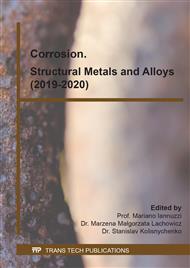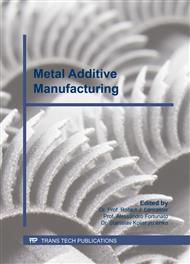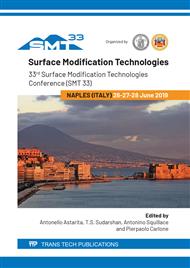p.62
p.68
p.74
p.80
p.86
p.92
p.98
p.104
p.110
Electrochemical Characterization of Ti6Al4V Components Produced by Additive Manufacturing
Abstract:
The investigation of the corrosion resistance of Ti6Al4V alloy components produced by additive technology is still lacking in the literature. This paper aims to study the electrochemical behaviour of Ti6Al4V components fabricated by laser powder-bed fusion additive manufacturing process. The metallographic analysis was carried out by an optical microscope. The electrochemical behaviour has been evaluated in 3.5 wt. % of natural aerated NaCl aqueous solution by potentiodynamic polarization test. The results have been compared to a conventionally manufactured Ti6Al4V component. The typical martensitic structure has been shown by the additive manufactured sample. As expected, the metallographic analysis revealed a martensitic microstructure. The electrochemical tests carried out on the surface of the as-received additive manufactured specimen showed an influence of its morphology on the values of passive current density, higher than that recorded for the conventionally manufactured sample, used as the control. After mechanical polishing, the electrochemical tests were repeated on the "bulk" of the samples. The open circuit potential values were higher than the value recorded for the conventionally manufactured sample. The conditions of the additive process affect the corrosion resistance of the components due to the roughness of the surface and to the microstructure created.
Info:
Periodical:
Pages:
86-91
Citation:
Online since:
July 2019
Authors:
Price:
Сopyright:
© 2019 Trans Tech Publications Ltd. All Rights Reserved
Share:
Citation:




